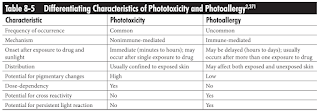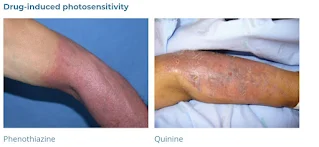Drug-Induced Photosenstivity
Introduction
Photosensitivity induced by exogenous agents refers to a process in which chemicals or drugs that are ingested or applied to the skin promote a photosensitivity reaction when the individual is exposed to sunlight.
- In one study, photosensitivity was responsible for approximately 20% of adverse drug reactions in elderly.
Photosensitivity reactions can be classified according to the underlying mechanism or pathogenesis of the reaction into either
- Phototoxicity
- Most common form
- Results from direct tissue or cellular damage following ultraviolet (UV) irradiation of a phototoxic agent that has been ingested or applied to the skin. Phototoxicity can occur in any individual in whom the threshold concentration of the chemical or drug has been reached.
- Appear as an exaggerated sunburn.
- Typical photosensitivity reactions may result in the development of erythema, oedema and papules, and in severe cases, may also progress to the development of plaque-like urticarial lesions and possible vesicle formation.
- The reaction usually evolves within minutes to hours of sun exposure and is restricted to exposed skin.
- Photoallergic
- Photoallergy is a delayed-type hypersensitivity reaction to an allergen whose antigenicity has changed after exposure to UV radiation (UVR; photoallergen). Once the photoallergen has formed, the subsequent steps in the pathogenesis of the reaction are identical to allergic contact dermatitis.
- Typically associated with an onset ranging from 24 to 48 hours to up to 14 days after initial exposure to the sun.
- The initial eruption is usually described as a papulovesicular, intensely pruritic, eczematous dermatitis. In some cases, the rash may involve lichenoid, urticarial, bullous or purpuric lesions.
Common Photosensitizing Medications
- Amiodarone
- Aminolaevulinic acid and methyl aminolaevulinate
- Fluoroquinolones
- Griseofulvin
- Hydrochlorothiazide
- Metformin
- NSAIDs, especially piroxicam and ketoprofen
- Phenothazines (e.g. chlorpromazine)
- Porfimer sodium
- Psoralens
- Retinoids
- St. John's wort
- Sulfonamides
- Tar compounds
- Tetracyclines (especially doxycycline)
- Vemurafenib
- Voriconazole
Management
For both phototoxic and photoallergic reactions, the offending drug or chemical causing exogenous photosensitivity should be discontinued whenever possible.
In cases where medication cannot be discontinued, sun protective measures are advised, such as
- Sun avoidance
- Sun-protective clothing
- Broad spectrum sunscreen
Most phototoxic reactions can be treated as sunburn.
- Symptomatic treatment with cool compresses, emollients, and oral analgesics usually suffice.
- Topical anesthetics should be avoided because of the possibility of a contact allergy.
Photoallergic reactions should be treated in a manner similar to contact allergy.
- Specifically, application of topical corticosteroids to the involved areas will reduce pruritus and the inflammatory response.
- In some instances, a two- to three-week course of systemic corticosteroids may be necessary.
External Links
- UpToDate - Photosensitivity disorders (photodermatoses): Clinical manifestations, diagnosis, and treatment
- Medscape - Drug-Induced Photosensitivity
- Drug-induced photosensitivity: culprit drugs, management and prevention, 2011
- Drug-Induced Photosensitivity-An Update: Culprit Drugs, Prevention and Management, 2019
- Phototoxicity: Its Mechanism and Animal Alternative Test Methods, 2015
- Skin Cancer Foundation - Photosensitivity


Comments
Post a Comment